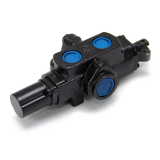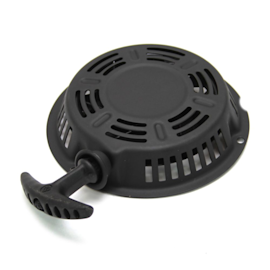Log Splitter: Why won't my log splitter's hydraulic cylinder extend the wedge?
A broken flexible pump coupler, clogged hydraulic fluid filter, failed hydraulic control valve, broken hydraulic pump or faulty hydraulic cylinder can prevent the hydraulic cylinder from extending the wedge on a log splitter.
Accessing the flexible pump coupler is fairly easy, so check that part first. The flexible pump coupler connects the engine drive shaft to the hydraulic pump. The coupler is designed to break if the hydraulic pump seizes up, protecting the engine from damage. Because the flexible coupler is plastic, the coupler can deteriorate over time and crack or break. Replace the flexible coupler if it's broken or damaged.
If the flexible coupler broke, try to rotate the hydraulic pump drive shaft with the drive shaft disconnected from the engine drive shaft to check for a locked-up hydraulic pump. If you can't rotate the hydraulic pump shaft, you'll likely need to replace the hydraulic pump. You'll also need to replace the hydraulic pump if it's leaking hydraulic fluid because the pump can't build up hydraulic fluid pressure to extend the wedge to split a piece of wood if its seals leak.
Hydraulic fluid leaking from the hydraulic control valve or hydraulic cylinder often indicates that the leaking part has failed. You'll likely need to replace the control valve and/or cylinder if they leak hydraulic fluid.
Although it doesn't happen often, a clogged hydraulic fluid filter can impede hydraulic fluid flow and prevent the cylinder from extending the wedge. Check the hydraulic fluid filter and replace the filter if it's clogged.

THESE REPAIRS MAY HELP SOLVE YOUR LOG SPLITTER PROBLEM

Replace the log splitter flexible pump coupler
The flexible pump coupler between the log splitter's engine and hydraulic pump breaks if the hydraulic pump seizes up, to protect the engine from damage. The flexible pump coupler on the log splitter hardens and deteriorates over time, and can break. When the flexible pump coupler is worn or broken, the engine and pump vibrate and rattle. If you detect vibration or noise coming from the hydraulic, check the flexible pump coupler and replace it if worn or broken.
Log splitter flexible pump coupler

How to replace a log splitter flexible pump coupler
If your log splitter vibrates a lot or the hydraulic cylinder won't move, the flexible pump coupler could be broken or worn. This easy-to-follow DIY repair guide shows how to replace the flexible log splitter hydraulic pump coupling in just 6 steps.

Replace the log splitter hydraulic oil filter
The hydraulic fluid filter removes debris from the hydraulic fluid in the log splitter. Replace the hydraulic oil filter after every 50 hours of log splitter use to extend the life of the hydraulic pump and hydraulic cylinder.
Log splitter hydraulic oil filter

Replace the log splitter hydraulic cylinder
The log splitter's hydraulic cylinder pushes and pulls the splitting wedge to split the wood. If the hydraulic cylinder leaks hydraulic fluid from around the seals, the cylinder won't move. Replace the hydraulic cylinder if it won't move properly.
Log splitter hydraulic cylinder

Replace the log splitter hydraulic pump
The log splitter's hydraulic pump generates the hydraulic pressure to extend the hydraulic cylinder and wedge. Over time, the hydraulic pump starting to leak fluid through worn seals when pumping hydraulic fluid. The pump eventually fails to build up enough hydraulic pressure to move the piston and wedge. If the pump seals are worn out, replace the hydraulic pump assembly. The hydraulic pump can also seize up due to an internal pump failure. If the hydraulic pump in the log splitter seizes up, replace the pump.
Log splitter hydraulic pump

Replace the log splitter hydraulic control valve
The log splitter's hydraulic control valve directs the hydraulic fluid flow to the hydraulic cylinder to extend and retract the piston and wedge. The hydraulic valve has seals around the actuator rod that can wear out and fail over time. If hydraulic fluid leaks from the valve body around the actuator rod, replace the hydraulic valve in the log splitter.
Log splitter hydraulic control valve
Most common symptoms to help you fix your log splitters
Choose a symptom to see related log splitter repairs.
Main cause: worn hydraulic valve seals around the actuator rod…
Main causes: broken pump coupler, clogged hydraulic fluid filter, bad hydraulic control valve, broken hydraulic pump, ba…
Main cause: worn hydraulic cylinder seals…
Main cause: worn hydraulic pump seals…
Main causes: leaky head gasket, damaged sump gasket, leaky oil drain plug, damaged fuel line, bad carburetor seals…
Main causes: dirty carburetor, bad spark plug, clogged air filter, stale fuel…
Main causes: dirty carburetor, stale fuel, bad spark plug, broken recoil starter…
Most common repair guides to help fix your log splitters
These step-by-step repair guides will help you safely fix what’s broken on your log splitter.

How to replace a log splitter recoil starter
The recoil starter spins the engine on the log splitter when you pull the starter rope, and the rope retracts when relea…

How to replace a log splitter flexible pump coupler
The flexible nylon log splitter pump coupler deteriorates over time. Replace the flexible pump coupler if it begins to v…

How to replace a log splitter fuel line
The fuel line carries the fuel supply from the gas tank to the carburetor. If the fuel line is cracked and leaking, repl…
Effective articles & videos to help repair your log splitters
Use the advice and tips in these articles to get the most out of your log splitter.

This chart will help you find the right carburetor for your Craftsman snowblower, tiller or log splitter.…

Learn more about your log splitter with these frequently asked questions.…

Learn how to change the hydraulic fluid in your log splitter.…